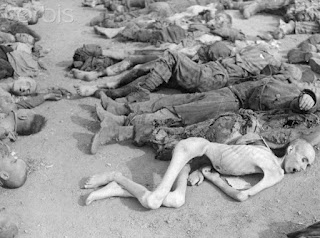When the Allies found WWII Nazi concentration camps, they organize the survival and repatriation of detainees in the first few months
 |
| The sight of dead bodies was usually the first thing the Allies saw when entering a Concentration Camp |
 |
| Inmate waiting for repatriation |
 |
| Sick and wounded camp inmate |
When the Allies found WWII Nazi concentration camps, they organize the survival and repatriation of detainees in the first few months
The general procedures varied somewhat from camp to camp, but the British and Americans generally followed the same system. The Soviet liberation of camps was far different and outside the scope of this question.
In general, most of the western camps were formally surrendered by the Germans. In almost all cases, the majority of the camp staff had left the camp ahead of time except for just a few German personnel who stayed behind to contact the approaching Allied forces and formally surrender. Roll calls had been stopped and prisoners were wandering around the compound looking for food and any other valuables. Dead were left where they fell and this was the sight which presented itself to the arriving Allied soldiers.
The first thing the Allies did was secure the camp from the Germans. This would involve sweeping the camp for any Germans who were still armed and then formally arresting any German personnel. This part of the process often resulted in some vigilante acts, such as the killing of German guards or handing over Germans to be attacked by the now liberated prisoners. The most serious occurrence was at Dachau where it was suspected Americans had rounded up and summarily executed a number of German personnel.
After the camp was secured, the Allies would ironically make certain that none of the prisoners could leave. This was done for a lot of reasons; mostly for the prisoners’ own safety. Within a few hours of liberating a camp, the Allies would begin to take count of how many prisoners they were dealing with and also identify “camp leaders”, i.e. prisoners who spoke English and could act as liaisons with the Allied soldiers.
Also in the first few hours medical personnel would begin treating camp inmates who were sick or wounded. By the end of the first day, a camp infirmary was usually up and running. At the same time, Allied soldiers would begin burying the bodies of the dead usually with the help of German POWs and civilians.
The priority during the first week was to get people fed but also to ensure that no gorging took place. Medical personnel had warned former inmates that many prisoners who had raided foodstuffs had become sick or had died after eating large amounts of food after a state of near starvation. To stop this from happening, liberated prisoners would be given rations slowly at first. To oversee these activates, the Allied authorities would set up supply offices in liberated camps which would be in charge of getting food and clothing to the inmates.
The first month after liberation was occupied by two main activities. The first was to register the former prisoners, find out who they were, and where they originally had come from. The second was to begin investigations into SS war crimes. In most of the camps, large administration offices were set up to start processing former inmates for repatriation. Each admin office also had a war crimes desk which would investigate the SS actions at the camp.
By about the third month, the inmates still alive were getting healthier and by this point the SS had been shipped out to other POW camps or special interrogation centers. The next several weeks saw the slow process of repatriation where the Allies would assist the inmates with returning to their homes. In cases where the homes no longer existed, or the region was under Soviet occupation, the Allies would suggest alternative locations within Germany or suggest emigration.
By about the six month point, most of the prisoners had been repatriated. The former concentration camps were then usually converted into military barracks for the Allies and also as prisons for the Germans who were now facing war crime trials. By the spring of 1946, most of the camps had been cleared of prisoners with the repatriation process complete.












Comments
Post a Comment